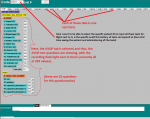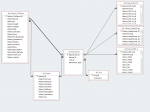Hi guys,
I am a graduate student and I'm "trying" (very hard though) to create a relational database in Access for my thesis study.
Basically, I have recruited patients that I evaluated with a battery of tests and questionnaires.
I'm having trouble to set my table relationships so I have the possibility of recording follow-ups if I need too (although I don't plan to do it in a near future, I want this feature enabled as I might use the database template for other studies).
Basically, I'll have 80 patients and they'll be each recorded in my "demographics" table (tbl_Patient).
Each of them will undergo an extensive battery of tests and questionnaires. I have created 3 tables for 3 of these (GDS15,DRS2,APATHY).
Every patient will at least be evaluated at baseline (T0). I may do some follow ups with all or a part of my battery later on (T1, T2, T ...).
...).
I'm a newbie and I'm completely lost in all this relationship process, even though I read a lot of them. I know I need a junction table for my baseline/follow up problem. I created one "tbl_PatientTime" ... but I'm kinda lost on how to set the "tbl_Time"... (see picture attached below)
Please see that link for a screenshot of my actual database relationships figure (had to cut the www part so I could post, couldn't insert image as I don't have over 10 posts...)
dropbox.com/s/mq0jarabkhsxa3z/access_help.jpg
If it's easier for you, here's a link to the database (at least what I've done so far)
dropbox.com/s/6agzj1i7btz5dyb/DOIRON_LABO_NPGv2013-11-20c.laccdb
PS: screen capture and database are attached in the message as well.
Thank you SO VERY MUCH for your help and pardon my english.
Regards,
Max
I am a graduate student and I'm "trying" (very hard though) to create a relational database in Access for my thesis study.
Basically, I have recruited patients that I evaluated with a battery of tests and questionnaires.
I'm having trouble to set my table relationships so I have the possibility of recording follow-ups if I need too (although I don't plan to do it in a near future, I want this feature enabled as I might use the database template for other studies).
Basically, I'll have 80 patients and they'll be each recorded in my "demographics" table (tbl_Patient).
Each of them will undergo an extensive battery of tests and questionnaires. I have created 3 tables for 3 of these (GDS15,DRS2,APATHY).
Every patient will at least be evaluated at baseline (T0). I may do some follow ups with all or a part of my battery later on (T1, T2, T
I'm a newbie and I'm completely lost in all this relationship process, even though I read a lot of them. I know I need a junction table for my baseline/follow up problem. I created one "tbl_PatientTime" ... but I'm kinda lost on how to set the "tbl_Time"... (see picture attached below)
Please see that link for a screenshot of my actual database relationships figure (had to cut the www part so I could post, couldn't insert image as I don't have over 10 posts...)
dropbox.com/s/mq0jarabkhsxa3z/access_help.jpg
If it's easier for you, here's a link to the database (at least what I've done so far)
dropbox.com/s/6agzj1i7btz5dyb/DOIRON_LABO_NPGv2013-11-20c.laccdb
PS: screen capture and database are attached in the message as well.
Thank you SO VERY MUCH for your help and pardon my english.
Regards,
Max









